Biotechnical Control of Varroa in Honey Bee Colonies: A Trade-Off between Sustainable Beekeeping and Profitability?
Abstract
:Simple Summary
Abstract
1. Introduction
2. Materials and Methods
3. Results
4. Discussion
Author Contributions
Funding
Data Availability Statement
Acknowledgments
Conflicts of Interest
References
- Klein, A.M.; Vaissière, B.E.; Cane, J.H.; Steffan-Dewenter, I.; Cunningham, S.A.; Kremen, C.; Tscharntke, T. Importance of pollinators in changing landscapes for world crops. Proc. R. Soc. B Biol. Sci. 2007, 274, 303–313. [Google Scholar] [CrossRef]
- Hein, L. The economic value of the pollination service, a review across scales. Open Ecol. J. 2009, 2, 74–82. [Google Scholar] [CrossRef]
- Gallai, N.; Salles, J.M.; Settele, J.; Vaissière, B.E. Economic valuation of the vulnerability of world agriculture confronted with pollinator decline. Ecol. Econ. 2009, 68, 810–821. [Google Scholar] [CrossRef]
- Leonhardt, S.D.; Gallai, N.; Garibaldi, L.A.; Kuhlmann, M.; Klein, A.M. Economic gain, stability of pollination and bee diversity decrease from southern to northern Europe. Basic Appl. Ecol. 2013, 14, 461–471. [Google Scholar] [CrossRef]
- Ferrazzi, P.; Vercelli, M.; Chakir, A.; Romane, A.; Mattana, M.; Consonni, R. Pollination effects on antioxidant content of Perilla frutescens seeds analysed by NMR spectroscopy. Nat. Prod. Res. 2017, 31, 2705–2711. [Google Scholar] [CrossRef] [PubMed]
- Mekious, S.; Masseaux, C.; Loucif-Ayad, W.; Vercelli, M. Pollen quality and sensory attributes of Algerian jujube (Ziziphus lotus (L.) Lam.) honeys. Acta Agric. Slov. 2022, 118, 2690. [Google Scholar] [CrossRef]
- Hellner, M.; Winter, D.; von Georgi, R.; Münstedt, K. Apitherapy: Usage and experience in german beekeepers. Evid. Based Complement. Alternat. Med. 2008, 5, 475–479. [Google Scholar] [CrossRef] [PubMed]
- Potts, S.G.; Imperatriz-Fonseca, V.; Ngo, H.T.; Aizen, M.A.; Biesmeijer, J.C.; Breeze, T.D.; Dicks, L.V.; Garibaldi, L.A.; Hill, R.; Settele, J.; et al. Safeguarding pollinators and their values to human well-being. Nature 2016, 540, 220–229. [Google Scholar] [CrossRef]
- Arih, I.K.; Korošec, T.A. Api-tourism: Transforming Slovenia’s Apicultural Traditions Into A Unique Travel Experience. WIT Trans. Ecol. Environ. 2015, 193, 963–974. [Google Scholar]
- Klein, A.M.; Boreux, V.; Fornoff, F.; Mupepele, A.C.; Pufal, G. Relevance of wild and managed bees for human well-being. Curr. Opin. Insect Sci. 2018, 26, 82–88. [Google Scholar] [CrossRef]
- Kluser, S.; Peduzzi, P. Global Pollinator Decline: A Litterature Review; UNEP/GRID-Europe: Geneva, Switzerland, 2007; Available online: https://wedocs.unep.org/20.500.11822/40959 (accessed on 13 May 2023).
- Potts, S.G.; Roberts, S.P.M.; Dean, R.; Marris, G.; Brown, M.A.; Jones, R.; Neumann, P.; Settele, J. Declines of managed honey bees and beekeepers in Europe. J. Apicult. Res. 2010, 49, 15–22. [Google Scholar] [CrossRef]
- Chauzat, M.P.; Cauquil, L.; Roy, L.; Franco, S.; Hendrikx, P.; Ribière-Chabert, M. Demographics of the European apicultural industry. PLoS ONE 2013, 8, e79018. [Google Scholar] [CrossRef] [PubMed]
- FAO. Good Beekeeping Practices: Practical Manual on How to Identify and Control the Main Diseases of the Honeybee (Apis mellifera); TECA—Technologies and Practices for Small Agricultural Producers, 1; FAO: Rome, Italy, 2020. [Google Scholar] [CrossRef]
- Le Conte, Y.; Navajas, M. Climate change: Impact on honey bee populations and diseases. Rev. Sci. Tech. Off. Int. Epiz. 2008, 27, 499–510. [Google Scholar]
- Goulson, D.; Nicholls, E.; Botías, C.; Rotheray, E.L. Bee declines driven by combined stress from parasites, pesticides, and lack of flowers. Science 2015, 347, 1255957. [Google Scholar] [CrossRef] [PubMed]
- Cornelissen, B.; Neumann, P.; Schweiger, O. Global warming promotes biological invasion of a honey bee pest. Glob. Chang. Biol. 2019, 25, 3642–3655. [Google Scholar] [CrossRef]
- Vercelli, M.; Novelli, S.; Ferrazzi, P.; Lentini, G.; Ferracini, C. A qualitative analysis of beekeepers’ perceptions and farm management adaptations to the impact of climate change on honey bees. Insects 2021, 12, 228. [Google Scholar] [CrossRef]
- Novelli, S.; Vercelli, M.; Ferracini, C. An easy mixed-method analysis tool to support rural development strategy decision-making for beekeeping. Land 2021, 10, 675. [Google Scholar] [CrossRef]
- Macchio, S.; Vercelli, M.; Gori, M.; Nazzini, L.; Bellucci, V.; Bianco, P.M.; Rivella, E.; D’Antoni, S. A standardized method for estimating environmental and agronomic covariates to discriminate the explanatory variables effects on bioindicators: A case study on soil fauna. Int. J. Sustain. Agric. Manag. Inform. 2023. [Google Scholar] [CrossRef]
- Rosenkranz, P.; Aumeier, P.; Ziegelmann, B. Biology and control of Varroa destructor. J. Invertebr. Pathol. 2010, 103, S96–S119. [Google Scholar] [CrossRef]
- Mondet, F.; de Miranda, J.R.; Kretzschmar, A.; Le Conte, Y.; Mercer, A.R. On the Front Line: Quantitative Virus Dynamics in Honeybee (Apis mellifera L.) Colonies along a New Expansion Front of the Parasite Varroa destructor. PLoS Pathog. 2014, 10, e1004323. [Google Scholar] [CrossRef]
- Adjlane, N.; Tarek, E.O.; Haddad, N. Evaluation of oxalic acid treatments against the mite Varroa destructor and secondary effects on honey bees Apis mellifera. J. Arthropod-Borne Dis. 2016, 10, 501–509. [Google Scholar] [PubMed]
- Barroso-Arévalo, S.; Fernández-Carrión, E.; Goyache, J.; Molero, F.; Puerta, F.; Sánchez-Vizcaíno, J.M. High load of deformed wing virus and Varroa destructor infestation are related to weakness of honey bee colonies in Southern Spain. Front. Microbiol. 2019, 10, 1331. [Google Scholar] [CrossRef] [PubMed]
- Nicholson, C.C.; Egan, P.A. Natural hazard threats to pollinators and pollination. Glob. Chang. Biol. 2020, 26, 380–391. [Google Scholar] [CrossRef] [PubMed]
- Underwood, R.M.; Traver, B.E.; López-Uribe, M.M. Beekeeping management practices are associated with operation size and beekeepers’ philosophy towards in-hive chemicals. Insects 2019, 10, 10. [Google Scholar] [CrossRef] [PubMed]
- Dietemann, V.; Nazzi, F.; Martin, S.J.; Anderson, D.L.; Locke, B.; Delaplane, K.S.; Wauquiez, Q.; Tannahill, C.; Frey, E.; Ziegelmann, B.; et al. Standard methods for varroa research. J. Apic. Res. 2013, 52, 1–54. [Google Scholar] [CrossRef]
- Lodesani, M.; Costa, C.; Besana, A.; Dall’Olio, R.; Franceschetti, S.; Tesoriero, D.; Giacomo, D. Impact of control strategies for Varroa destructor on colony survival and health in northern and central regions of Italy. J. Apic. Res. 2014, 53, 155–164. [Google Scholar] [CrossRef]
- Gregorc, A.; Sampson, B. Diagnosis of Varroa Mite (Varroa destructor) and Sustainable Control in Honey Bee (Apis mellifera) Colonies—A Review. Diversity 2019, 11, 243. [Google Scholar] [CrossRef]
- Smodiš Škerl, M.I.; Rivera-Gomis, J.; Tlak Gajger, I.; Bubnič, J.; Talakić, G.; Formato, G.; Baggio, A.; Mutinelli, F.; Tollenaers, W.; Laget, D.; et al. Efficacy and Toxicity of VarroMed® Used for Controlling Varroa destructor Infestation in Different Seasons and Geographical Areas. Appl. Sci. 2021, 11, 8564. [Google Scholar] [CrossRef]
- Brodschneider, R.; Schlagbauer, J.; Arakelyan, I.; Ballis, A.; Brus, J.; Brusbardis, V.; Cadahía, L.; Charrière, J.-D.; Chlebo, R.; Coffey, M.F.; et al. Spatial clusters of Varroa destructor control strategies in Europe. J. Pest. Sci. 2023, 96, 759–783. [Google Scholar] [CrossRef]
- Loucif-Ayad, W.; Aribi, N.; Smagghe, G.; Soltani, N. Comparative effectiveness of some acaricides used to control Varroa destructor (Mesostigmata: Varroidae) in Algeria. Afr. Entomol. 2010, 18, 259–266. [Google Scholar] [CrossRef]
- Kamler, M.; Nesvorna, M.; Stara, J.; Erban, T.; Hubert, J. Comparison of tau-fluvalinate, acrinathrin, and amitraz effects on susceptible and resistant populations of Varroa destructor in a vial test. Exp. Appl. Acarol. 2016, 69, 1–9. [Google Scholar] [CrossRef] [PubMed]
- Rinkevich, F.D. Detection of amitraz resistance and reduced treatment efficacy in the Varroa Mite, Varroa destructor, within commercial beekeeping operations. PLoS ONE 2020, 15, e0227264. [Google Scholar] [CrossRef] [PubMed]
- Floris, I.; Satta, A.; Cabras, P.; Garau, V.L.; Angioni, A. Comparison between two thymol formulations in the control of Varroa destructor: Effectiveness, persistence, and residues. J. Econ. Entomol. 2004, 97, 187–191. [Google Scholar] [CrossRef] [PubMed]
- Sammataro, D.; Untalan, P.; Guerrero, F.; Finley, J. The resistance of varroa mites (Acari: Varroidae) to acaricides and the presence of esterase. Int. J. Acarol. 2005, 31, 67–74. [Google Scholar] [CrossRef]
- Bogdanov, S. Contaminants of bee products. Apidologie 2006, 37, 1–18. [Google Scholar] [CrossRef]
- Maggi, M.D.; Ruffinengo, S.R.; Damiani, N.; Sardella, N.H.; Eguaras, M.J. First detection of Varroa destructor resistance to coumaphos in Argentina. Exp. Appl. Acarol. 2009, 47, 317–320. [Google Scholar] [CrossRef]
- Hernández-Rodríguez, C.S.; Marín, Ó.; Calatayud, F.; Mahiques, M.J.; Mompó, A.; Segura, I.; Simó, E.; González-Cabrera, J. Large-Scale Monitoring of Resistance to Coumaphos, Amitraz, and Pyrethroids in Varroa destructor. Insects 2021, 12, 27. [Google Scholar] [CrossRef]
- Kouchner, C.; Ferrus, C.; Blanchard, S.; Decourtye, A.; Basso, B.; Le Conte, Y.; Tchamitchian, M. Bee farming systems sustainability: An assessment framework in France. Agric. Syst. 2019, 176, 102653. [Google Scholar] [CrossRef]
- Pietropaoli, M.; Skerl, M.S.; Cazier, J.; Riviere, M.P.; Tiozzo, B.; Eggenhoeffner, R.; Gregorc, A.; Haefeker, W.; Higes, M.; Ribarits, A.; et al. BPRACTICES Project: Towards a Sustainable European Beekeeping. Bee World 2020, 97, 66–69. [Google Scholar] [CrossRef]
- FAO; IZSLT; Apimondia; CAAS. Good Beekeeping Practices for Sustainable Apiculture; FAO Animal Production and Health Guidelines, No. 25; FAO: Rome, Italy, 2021. [Google Scholar]
- Gregorc, A.; Adamczyk, J.; Kapun, S.; Planinc, I. Integrated varroa control in honey bee (Apis mellifera carnica) colonies with or without brood. J. Apic. Res. 2016, 55, 253–258. [Google Scholar] [CrossRef]
- Delaplane, K.S.; Berry, J.A.; Skinner, J.A.; Parkman, J.P.; Hood, W.M. Integrated pest management against Varroa destructor reduces colony mite levels and delays treatment threshold. J. Apic. Res. 2005, 44, 157–162. [Google Scholar] [CrossRef]
- Sabahi, Q.; Morfin, N.; Emsen, B.; Gashout, H.A.; Kelly, P.G.; Otto, S.; Merrill, A.R.; Guzman-Novoa, E. Evaluation of Dry and Wet Formulations of Oxalic Acid, Thymol, and Oregano Oil for Varroa Mite (Acari: Varroidae) Control in Honey Bee (Hymenoptera: Apidae) Colonies. J. Econ. Entomol. 2020, 113, 2588–2594. [Google Scholar] [CrossRef] [PubMed]
- Fries, I.; Hansen, H. Biotechnical control of varroa mites in cold climates. Am. Bee J. 1993, 133, 435–438. [Google Scholar]
- Hoopingarner, R. Biotechnical control of varroa mites. In Mites of the Honey Bee; Webster, T.C., Delaplane, K.S., Eds.; Dadant: Hamilton, IL, USA, 2001; pp. 197–204. [Google Scholar]
- Plettner, E.; Eliash, N.; Singh, N.K.; Pinnelli, G.R.; Soroker, V. The chemical ecology of host-parasite interaction as a target of Varroa destructor control agents. Apidologie 2017, 48, 78–92. [Google Scholar] [CrossRef]
- Calderone, N.W. Evaluation of drone brood removal for management of Varroa destructor (Acari: Varroidae) in colonies of Apis mellifera (Hymenoptera: Apidae) in the Northeastern United States. J. Econ. Entomol. 2005, 98, 645–650. [Google Scholar] [CrossRef] [PubMed]
- Giacomelli, A.; Pietropaoli, M.; Carvelli, A.; Iacoponi, F.; Formato, G. Combination of thymol treatment (Apiguard®) and caging the queen technique to fight Varroa destructor. Apidologie 2016, 47, 606–616. [Google Scholar] [CrossRef]
- Gregorc, A.; Alburaki, M.; Werle, C.; Knight, P.R.; Adamczyk, J. Brood removal or queen caging combined with oxalic acid treatment to control varroa mites (Varroa destructor) in honey bee colonies (Apis mellifera). Apidologie 2017, 48, 821–832. [Google Scholar] [CrossRef]
- Büchler, R.; Uzunov, A.; Kovačić, M.; Prešern, J.; Pietropaoli, M.; Hatjina, F.; Pavlov, B.; Charistos, L.; Formato, G.; Galarza, E.; et al. Summer brood interruption as integrated management strategy for effective Varroa control in Europe. J. Apic. Res. 2020, 59, 764–773. [Google Scholar] [CrossRef]
- Bubnič, J.; Moosbeckhofer, R.; Prešern, J.; Moškrič, A.; Formato, G.; Pietropaoli, M.; Gregorc, A.; Muz, M.N.; Škerl, M.I.S. Three pillars of Varroa control. Apidologie 2021, 52, 1305–1333. [Google Scholar] [CrossRef]
- Tubene, S.; Kulhanek, K.; Rennich, K.; van Engelsdorp, D. Best Management Practices Increase Profitability of Small-Scale US Beekeeping Operations. J. Econ. Entomol. 2023, 116, 47–55. [Google Scholar] [CrossRef]
- Al-Ghamdi, A.A.; Adgaba, N.; Herab, A.H.; Ansari, M.J. Comparative analysis of profitability of honey production using traditional and box hives. Saudi J. Biol. Sci. 2017, 24, 1075–1080. [Google Scholar] [CrossRef]
- Jones, R. European beekeeping in the 21st century: Strengths, weaknesses, opportunities, threat. Bee World 2004, 85, 77–80. [Google Scholar] [CrossRef]
- Tucak, Z.; Perispic, M.; Beslo, D.; Tucak, I. Influence of the beehive type on the quality of honey. Coll. Antropol. 2004, 28, 463–467. [Google Scholar] [PubMed]
- Urbisci, L. The Economic Effects of Size and Enterprise Diversity on Apiary Profits in Canada. Master’s Thesis, University of Gulf, Sanad, Bahrain, 2011. [Google Scholar]
- Saner, G.; Engindeniz, S.; Tolon, B.; Cukur, F. The economic analysis of beekeeping enterprise in sustainable development: The case study of Turkey. Apiacta 2004, 38, 342–351. [Google Scholar]
- Hoover, S.E.; Ovinge, L.P. Pollen collection, honey production, and pollination services: Managing honey bees in an agricultural setting. J. Econ. Entomol. 2018, 111, 1509–1516. [Google Scholar] [CrossRef] [PubMed]
- Mancuso, T.; Croce, L.; Vercelli, M. Total brood removal and other biotechniques for the sustainable control of varroa mites in honey bee colonies: Economic impact in beekeeping farm case studies in northwestern Italy. Sustainability 2020, 12, 2302. [Google Scholar] [CrossRef]
- Vercelli, M.; Croce, L.; Mancuso, T. An economic approach to assess the annual stock in beekeeping farms: The honey bee colony inventory tool. Sustainability 2020, 12, 9258. [Google Scholar] [CrossRef]
- Osservatorio Nazionale del Miele. Il Valore Della Terra; Multimediale, R., Pietro, C.S., Eds.; Osservatorio Nazionale del Miele: Bologna, Italy, 2023; Volume 1, p. 94. [Google Scholar]
- Viliani, L.; Bonelli, S.; Vercelli, M.; Roy, D.B.; Riva, F. Does a short Pollard walk transect capture butterfly and bee diversity? A test to inform pollinator monitoring and community science initiatives. Insect Conserv. Divers. 2022, 15, 645–654. [Google Scholar] [CrossRef]
- Van Engelsdorp, D.; Meixner, M.D. A historical review of managed honey bee populations in Europe and the United States and the factors that may affect them. J. Invertebr. Pathol. 2010, 103, S80–S95. [Google Scholar] [CrossRef]
- Beyer, M.; Junk, J.; Eickermann, M.; Clermont, A.; Kraus, F.; Georges, C.; Reichart, A.; Hoffmann, L. Winter honey bee colony losses, Varroa destructor control strategies, and the role of weather conditions: Results from a survey among beekeepers. Res. Vet. Sci. 2018, 118, 52–60. [Google Scholar] [CrossRef]
- Haber, A.I.; Steinhauer, N.A.; van Engelsdorp, D. Use of chemical and nonchemical methods for the control of Varroa destructor (Acari: Varroidae) and associated winter colony losses in US beekeeping operations. J. Econ. Entomol. 2019, 112, 1509–1525. [Google Scholar] [CrossRef] [PubMed]
- Oberreiter, H.; Brodschneider, R. Austrian COLOSS survey of honey bee colony winter losses 2018/19 and analysis of hive management practices. Diversity 2020, 12, 99. [Google Scholar] [CrossRef]
- Rete Rurale. Italian Strategic Plan for CAP 2023–2027. 2022. Available online: https://www.reterurale.it/downloads/PSP_Italia_15112022.pdf (accessed on 17 May 2023).
- Ministero delle Politiche Agricole Alimentari e Forestali. Italian Budget Law in Article 1, Paragraphs 859, 860 and 862 of Law No. 234 of 30 December 2021, Concerning the ‘State Budget for the Financial Year 2022’. 2021. Available online: https://www.politicheagricole.it/flex/cm/pages/ServeBLOB.php/L/IT/IDPagina/18510 (accessed on 17 May 2023).
- Di Vita, G.; Pippinato, L.; Blanc, S.; Zanchini, R.; Mosso, A.; Brun, F. Understanding the role of purchasing predictors in the consumer’s preferences for PDO labelled honey. J. Food Prod. Mark. 2021, 27, 42–56. [Google Scholar] [CrossRef]
- Zanchini, R.; Blanc, S.; Pippinato, L.; Di Vita, G.; Brun, F. Consumers’ attitude towards honey consumption for its health benefits: First insights from an econometric approach. Br. Food J. 2022, 124, 4372–4386. [Google Scholar] [CrossRef]
- Pippinato, L.; Blanc, S.; Mancuso, T.; Brun, F. A sustainable niche market: How does honey behave? Sustainability 2020, 12, 10678. [Google Scholar] [CrossRef]
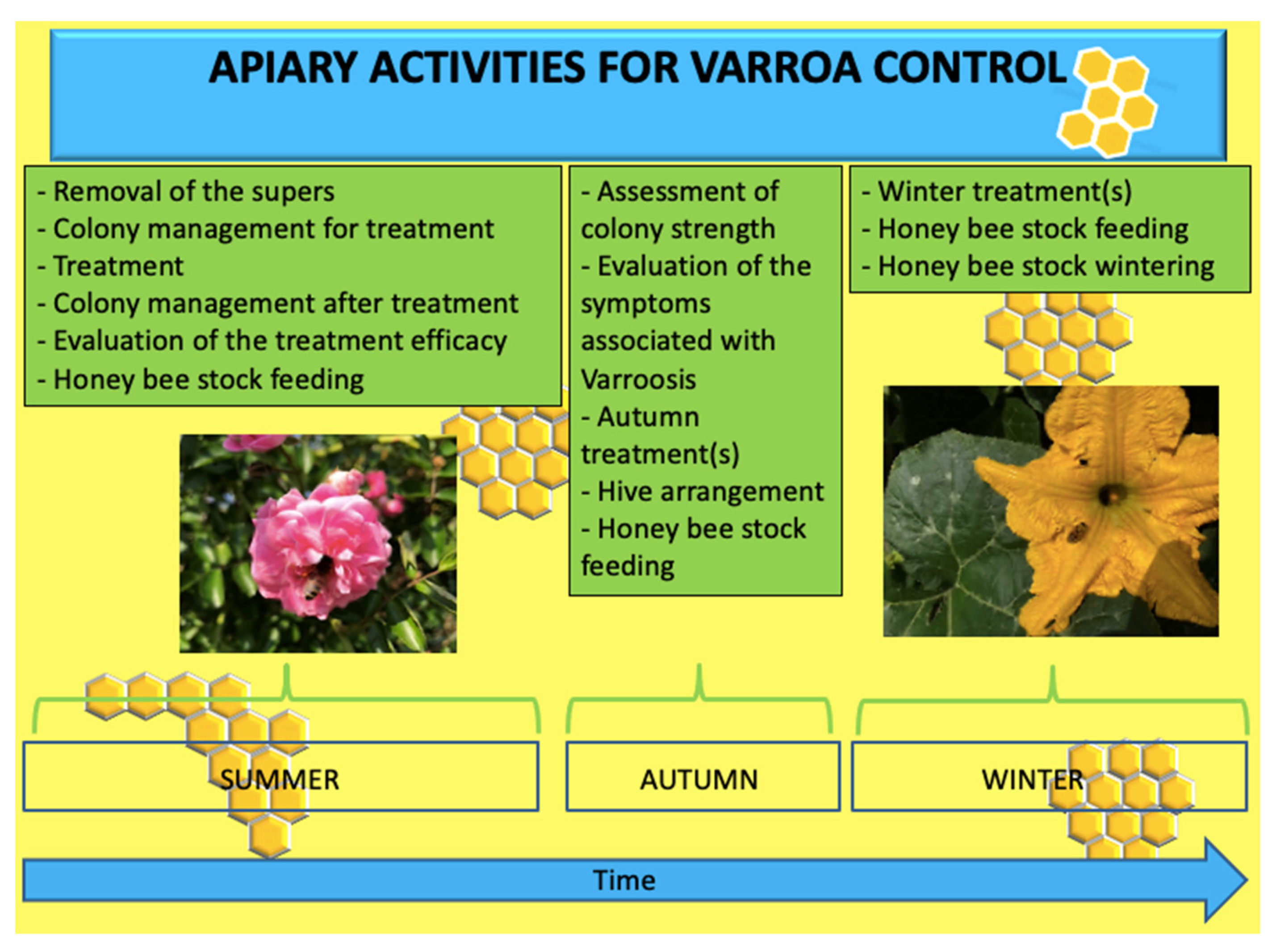
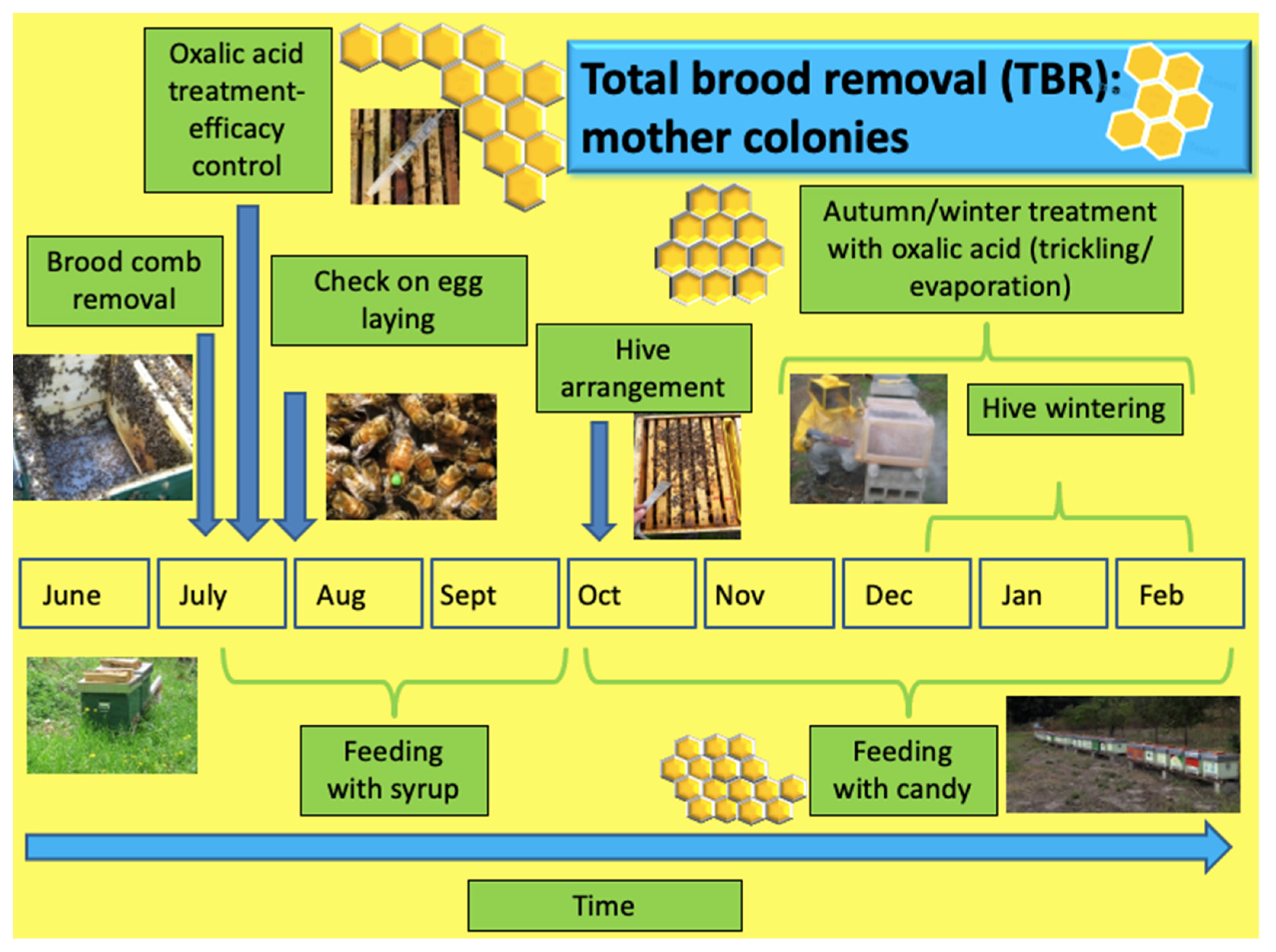
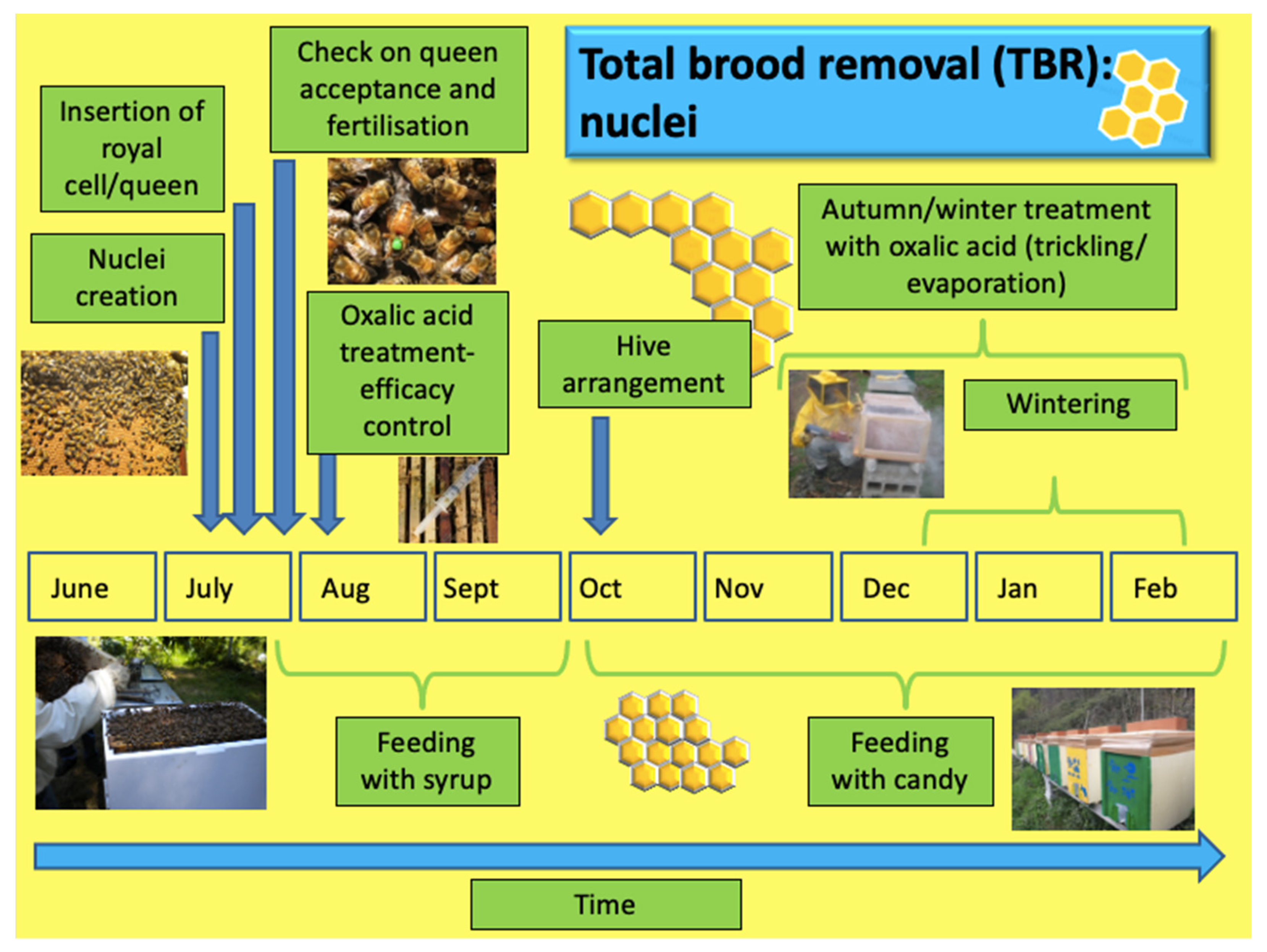

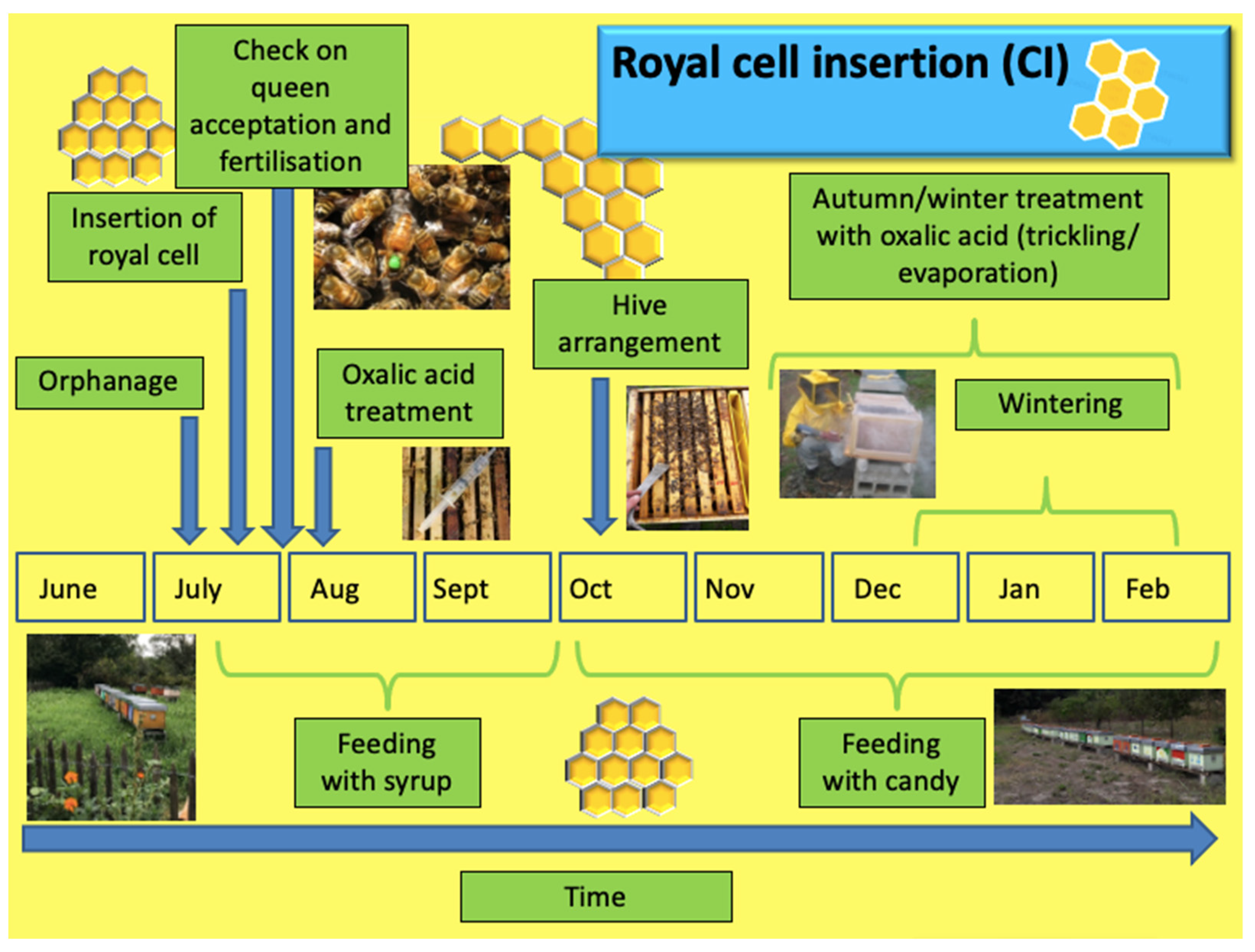
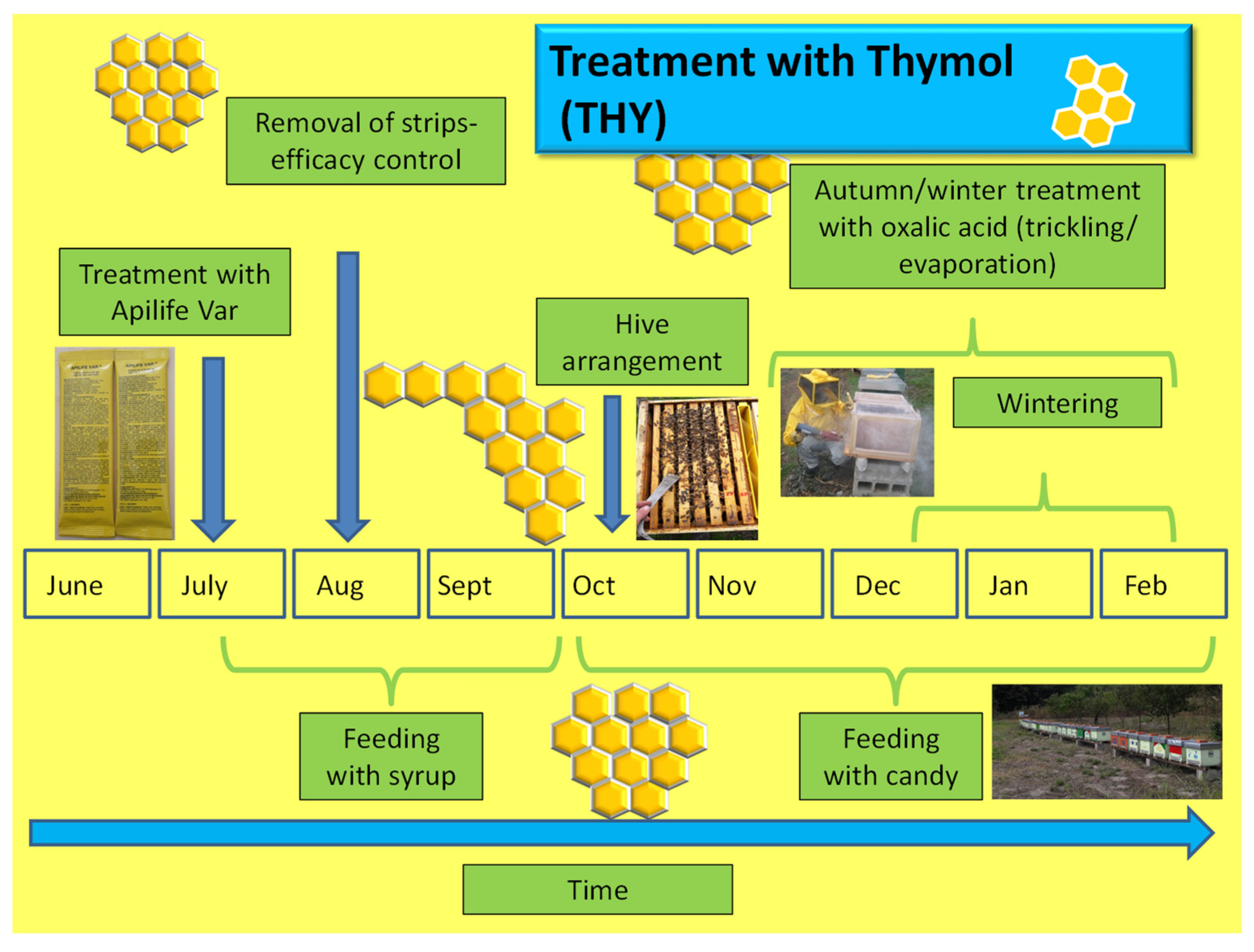
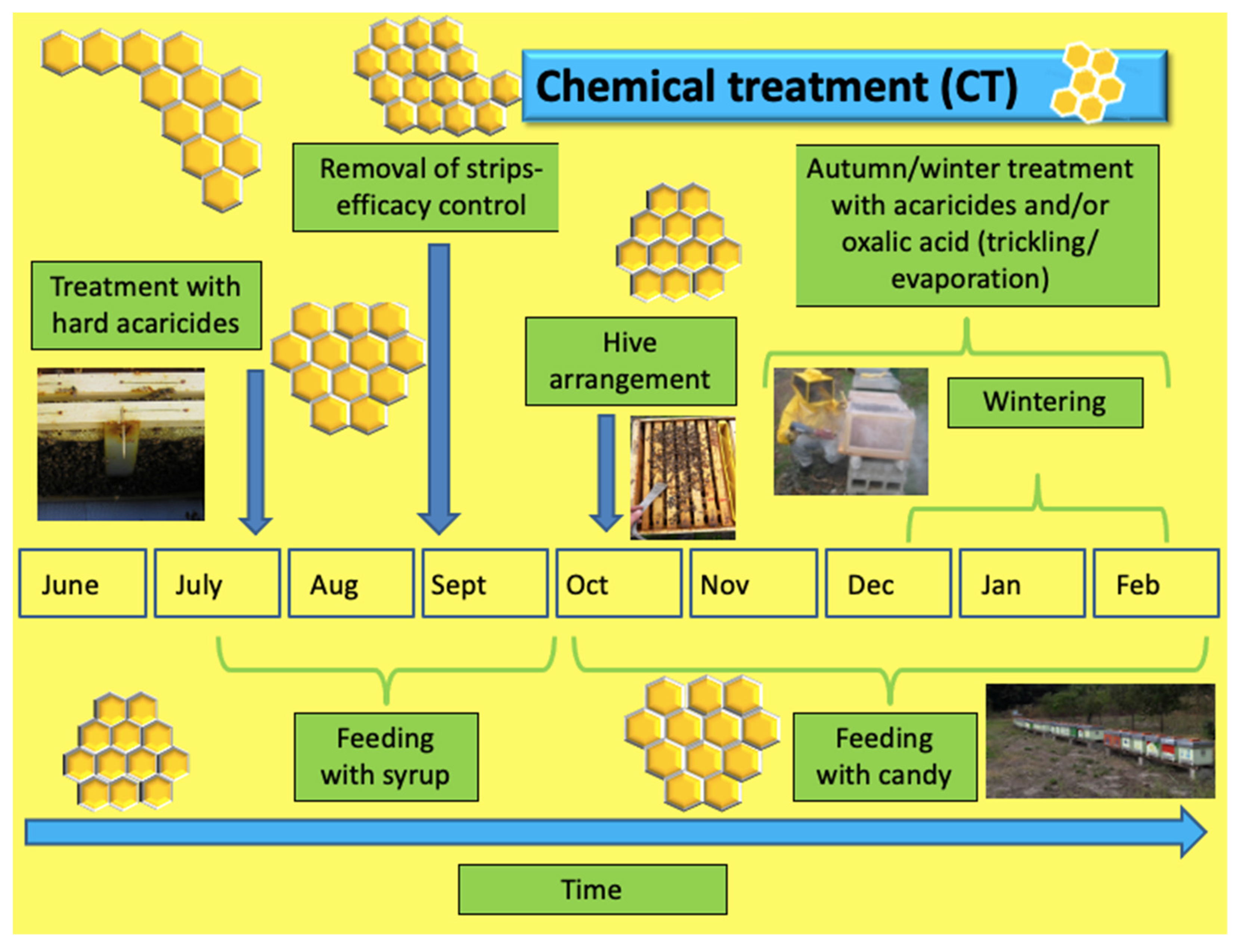
| Bee Farm ID | Number of Beehives in Summer | Number of TBR Beehives | Number of Beehives Subject to Other Techniques | Other Adopted Biotechniques * | Other Methods ** |
|---|---|---|---|---|---|
| 1 | 1000 | 200 | 800 | QC-CI | - |
| 2 | 850 | 100 | 750 | QC-CI | - |
| 3 | 190 | 50 | 140 | QC | - |
| 4 | 200 | 40 | 160 | QC-CI | - |
| 5 | 21 | 8 | 13 | THY | - |
| 6 | 160 | 160 | - | - | |
| 7 | 603 | - | - | - | CT |
| 8 | 1200 | - | - | - | CT |
| 9 | 150 | - | - | - | CT |
| Bee Farm Net Income (EUR/Hive) | |||||||||
|---|---|---|---|---|---|---|---|---|---|
| Varroa Control Technique * | 1 | 2 | 3 | 4 | 5 | 6 | 7 | 8 | 9 |
| TBR | 159.92 | 174.03 | 180.45 | 156.54 | 172.32 | 181.28 | - | - | - |
| QC | 106.34 | 138.87 | 155.24 | 113.27 | - | - | - | - | - |
| CI | 99.79 | 132.43 | - | 108.33 | - | - | - | - | - |
| THY | - | - | - | - | 99.57 | - | - | - | |
| CT | - | - | - | - | - | - | 88.41 | 82.81 | 193.65 |
Disclaimer/Publisher’s Note: The statements, opinions and data contained in all publications are solely those of the individual author(s) and contributor(s) and not of MDPI and/or the editor(s). MDPI and/or the editor(s) disclaim responsibility for any injury to people or property resulting from any ideas, methods, instructions or products referred to in the content. |
© 2023 by the authors. Licensee MDPI, Basel, Switzerland. This article is an open access article distributed under the terms and conditions of the Creative Commons Attribution (CC BY) license (https://creativecommons.org/licenses/by/4.0/).
Share and Cite
Vercelli, M.; Croce, L.; Mancuso, T. Biotechnical Control of Varroa in Honey Bee Colonies: A Trade-Off between Sustainable Beekeeping and Profitability? Insects 2023, 14, 830. https://doi.org/10.3390/insects14100830
Vercelli M, Croce L, Mancuso T. Biotechnical Control of Varroa in Honey Bee Colonies: A Trade-Off between Sustainable Beekeeping and Profitability? Insects. 2023; 14(10):830. https://doi.org/10.3390/insects14100830
Chicago/Turabian StyleVercelli, Monica, Luca Croce, and Teresina Mancuso. 2023. "Biotechnical Control of Varroa in Honey Bee Colonies: A Trade-Off between Sustainable Beekeeping and Profitability?" Insects 14, no. 10: 830. https://doi.org/10.3390/insects14100830
APA StyleVercelli, M., Croce, L., & Mancuso, T. (2023). Biotechnical Control of Varroa in Honey Bee Colonies: A Trade-Off between Sustainable Beekeeping and Profitability? Insects, 14(10), 830. https://doi.org/10.3390/insects14100830






